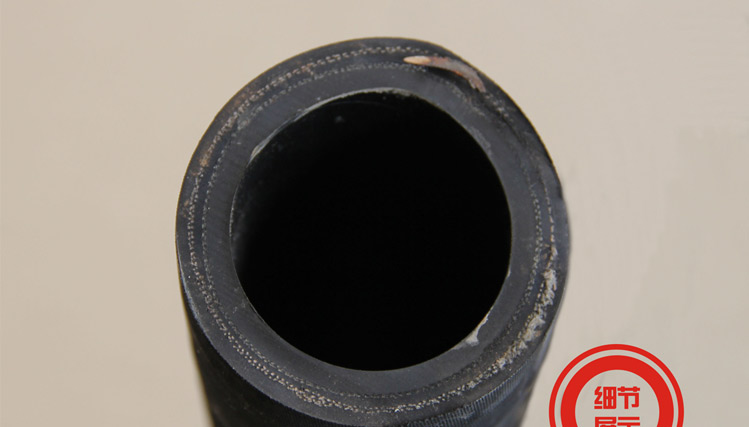In the field of modern engineering machinery, the efficient and stable operation of the hydraulic system is the key to ensure that all kinds of heavy equipment can successfully complete various complex tasks. As an indispensable connecting component in the hydraulic system, the oil-resistant high-pressure steel wire rubber hose assembly plays an important role in transmitting high-pressure liquids and withstanding extreme working conditions and vibration. This article will deeply explore the application and value of the oil-resistant high-pressure steel wire rubber hose assembly in the hydraulic system of engineering machinery from three aspects: material properties, structural design, application and maintenance.
1. Material properties: perfect combination of oil resistance, high pressure and high strength
The reason why the oil-resistant high-pressure steel wire rubber hose assembly can be widely used in the field of engineering machinery is primarily due to its unique material composition and excellent performance. The hose is mainly composed of four parts: inner rubber layer, reinforcement layer (steel wire braided or wound layer), middle rubber layer and outer rubber layer. Each layer has different functions and together constitutes the high-performance foundation of the hose assembly.
Inner rubber layer: directly in contact with hydraulic oil, it is required to have excellent oil resistance, wear resistance and sealing. Special rubber materials such as nitrile rubber (NBR), chloroprene rubber (CR) or ethylene-acrylic ester rubber (ACM) are usually used. These materials can effectively resist the erosion of hydraulic oil and maintain stability and reliability for long-term use.
Reinforcement layer: It is woven or wound with high-strength steel wire and is the core structure of the hose to withstand high pressure. Parameters such as the arrangement, diameter, and density of the steel wire directly affect the pressure bearing capacity and bending performance of the hose. The high-density steel wire braided layer can provide better pressure bearing capacity and burst resistance, while the winding layer focuses more on improving the axial tensile strength of the hose.
Middle rubber layer: It is located between the inner rubber layer and the reinforcement layer, which plays an isolation and buffering role, protects the inner rubber layer from direct wear of the steel wire, and enhances the overall flexibility and durability of the hose.
Outer rubber layer: As the outermost layer of the hose, its main function is to resist the erosion of the external environment such as ultraviolet rays, ozone, moisture, etc., while providing certain wear resistance and anti-aging properties. Commonly used materials include chlorosulfonated polyethylene (CSM), chloroprene rubber (CR), etc.
2. Structural design: flexibility and reliability to adapt to complex working conditions
The design of the oil-resistant high-pressure steel wire rubber hose assembly must not only meet the basic pressure transmission requirements, but also fully consider the various complex working conditions that engineering machinery may encounter in actual operations, such as extreme temperatures, high-frequency bending, impact loads, etc. Therefore, its structural design reflects a high degree of flexibility and reliability.
Multi-layer structure design: By scientifically and rationally configuring the materials and thickness of the inner rubber layer, reinforcement layer and outer rubber layer, the high-pressure bearing capacity of the hose is guaranteed, and good flexibility and wear resistance are ensured. This multi-layer structure design enables the hose to adapt to the needs of different pressure levels and working environments.
Joint design: The joints at both ends of the hose are usually crimped, welded or threaded to ensure a tight and firm connection with the pump, valve, cylinder and other components in the hydraulic system to prevent liquid leakage. The selection of joint materials is equally important. It needs to match the hose material and have good corrosion resistance to adapt to harsh working environments.
Bending radius optimization: For the application scenarios of frequent bending in construction machinery, the hose assembly will pay special attention to its minimum bending radius when designing, ensuring a more flexible layout and smaller space occupation without affecting the pressure transmission efficiency, thereby improving the flexibility and operating efficiency of the whole machine.
3. Application and maintenance: the key to ensuring efficient operation of the hydraulic system
The oil-resistant high-pressure steel wire rubber hose assembly is widely used in construction machinery, from excavators, loaders, cranes to rollers, concrete pump trucks, etc., covering almost all heavy equipment. The quality of its performance directly affects the overall efficiency of the hydraulic system and the reliability of the equipment.
Correct selection and installation: According to the specific operation requirements of the construction machinery and the working pressure, flow and other parameters of the hydraulic system, select the appropriate hose assembly model and specification. During installation, follow the manufacturer's guidance to ensure that the hose is in a reasonable direction, avoid excessive bending, twisting or external force extrusion, which affects the service life.
Regular inspection and maintenance: Regularly inspect the hose assembly, including whether the appearance is damaged or aging, whether the joint is loose or leaking, and the cleanliness of the inside of the hose. If a problem is found, it should be replaced or repaired in time to avoid the expansion of the fault and more serious consequences.
Storage and preservation: When not in use, the hose assembly should be stored in a dry, cool, well-ventilated place, avoiding direct sunlight and high temperature environment to prevent material aging. At the same time, the hose should be prevented from being in an excessively bent state for a long time to avoid affecting its performance.
In summary, as an indispensable component of the hydraulic system of construction machinery, the material properties, structural design and application maintenance of the oil-resistant high-pressure steel wire rubber hose assembly are crucial to ensure the efficient and stable operation of the hydraulic system. With the advancement of materials science and the continuous improvement of manufacturing technology, the future oil-resistant high-pressure steel wire rubber hose assembly will be more intelligent and lightweight, injecting new vitality into the development of the construction machinery industry.

